Gerry Feehan
Vancouver Island by Gerry Feehan
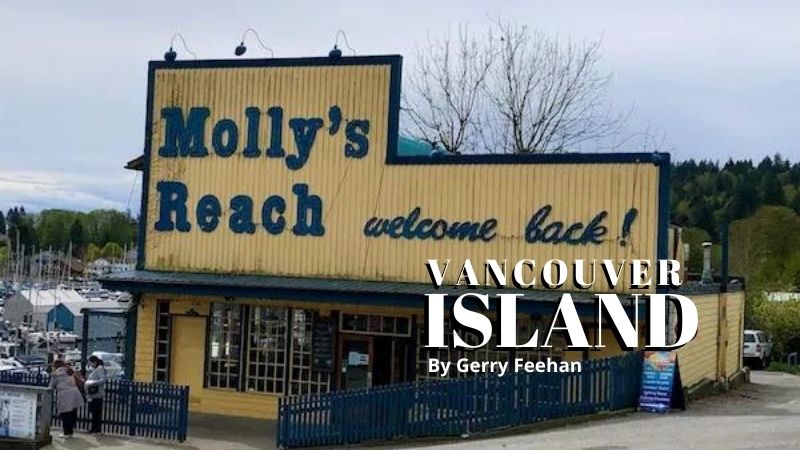
Let’s face it. April in Alberta sucks. Beneath the snowy mantle cold and clean… lies a bunch of dead brown grass. Meanwhile on Vancouver Island, spring is in bloom. The cherry trees are in full magenta majesty. The land is bright with magnolia and rhododendron blossoms and colourful tulips punctuate the evergreen grass. Hummingbirds flit amongst the flowers, sipping spring’s sweet nectar.

I’m not stupid. Last year on the first of April my wife and I packed our cozy little motorhome and headed for the coast. Avoiding the customary Vancouver to Victoria ferry route, we elected to travel up the Sunshine Coast, on the mainland to Powell River, before heading over to the Island.
I use the word ‘mainland’ loosely since, although technically attached to the continent, there is no direct road to Powell River. Getting there entails travel by ferry—two ferries actually. After departing Horseshoe Bay in North Vancouver, the first stop is Gibson’s, made famous by the old CBC series The Beachcombers. We combed Molly’s Reach unsuccessfully for Bruno Gerussi and Relic before navigating the steep road up and out of town and onto the Sunshine Coast Highway.
Soon we were serpentining through massive stands of hemlock, western red cedar and Douglas fir. We encountered the sea again at lovely Sechelt where we enjoyed a quiet hike through a towering old-growth forest—and a lively overnight stay with Sechelt friends. In the morning we followed the meandering road to Saltery Bay where we boarded our second ferry for the leg to Powell River.

We had hoped to avail ourselves of some Sunshine Coast tourist amenities—perhaps a day trip to Desolation Sound, a floatplane into Princess Louisa Inlet or a zodiac ride to Sechelt Narrows—but none of the operators had yet opened for the year.
Unfortunately, with a few notable exceptions, this became a recurring theme during our April trip to the wet, er I mean, west coast. That it was quiet was just as well. Highway 101 (which apparently originates 15,000 road miles away at the tip of South America) terminates at Lund, BC. And I mean, terminates. Had there been a couple more cars parked in front of the historic Lund Hotel, I’d still be trying to turn the motorhome around.
After retracing our path south to Powell River, we caught the late afternoon ferry for the run over to Comox on the Island. Our arrival was inauspicious. Rain poured down through the night. In the morning the windshield wipers were flapping time all the way to Port McNeill. Literally flapping. They were broken. But when we pulled into town the sky cleared and we enjoyed a lovely, crisp evening. The town was deserted. We had the world’s largest burl, a Port McNeil must-see, to ourselves.
For the uninitiated, a burl is an abnormal outgrowth on a tree, like a wart, or a giant blemish. This particular burl is six meters in diameter and is estimated to weigh 30 tonnes. That’s one big zit.

A few kilometres up the road is Port Hardy, which bills itself as a salmon fishing mecca. But the charters were all in dry dock. The run of spring salmon had yet to arrive. And the orcas that eat them were nowhere to be seen. So forget whale watching.
Perhaps this whole ‘Vancouver-Island-in-April’ thing was not such a great idea after all. But of course, it was. Sure, we got a bit wet here and there and, yes, some of the more touristy things weren’t yet open for business, but there was the quiet solitude, gorgeous hiking, camping in peaceful remote forests—and spring’s bright blossoms.
I unfurled my fly rod and spent a delightful day wading the Marble River, near Port Alice, casting every manner of lure onto those pristine mountain waters. Alas, I didn’t land a thing, despite digging deep into my fly box for the finest of flies. Clearly, the fish of Vancouver Island are either blind—or very stupid.

We had the Island’s campgrounds to ourselves
Pursuing more quiet isolation, we headed for Telegraph Cove, located on a dead-end road just south of Port McNeill. We phoned ahead to see if the campground was open but the pre-recorded message simply thanked patrons for ‘a great season’ and offered an encouraging ‘see you in the spring’.
We weren’t optimistic. We resigned ourselves to a night of boondocking in some remote pullout. Still, we pressed on and pulled into the cove just as the setting sun glimmered red on the calm, gorgeous bay of the tiny hamlet.

Telegraph Cove
Look up ‘quaint’ in the dictionary. There’ll be a picture of Telegraph Cove. The small harbour is surrounded by cute, rustic lodging; converted fishing shacks and charming motel units hang precariously over the water.
At the end of the pier stands the iconic rust-red Telegraph Cove Lumber & Trading Co., which now houses the Whale Interpretive Centre. Everything was shut fast. I peeked through the smoky windows of the local cafe. In a far corner, tables and chairs were upended and neatly stacked. Suddenly, out of nowhere, an older fellow, with a hitch in his gait and a sharp tool in his hand, appeared. ‘Can I help ya?’ he inquired, hoisting a hacksaw. I looked at Florence and shivered. It was reminiscent of The Shining.
‘We were hoping to find a spot to camp for the night,’ I mentioned nervously. ‘No problem,’ he said. ‘we’re not officially open yet but you’re welcome to pull in anywhere and hook up. No charge.’ He pointed up the hill toward a steep gravel road leading into the forest and a sign that read, ‘Camping.’ I turned to thank him. He was gone.
Still, we slept peacefully that night, lullabied to sleep by the rhythmic swaying of giant Douglas fir. In the morning we moseyed down to the boat ramp, intending to launch our inflatable kayak. The wind was gale-force. Outside the harbour entrance, the roiling sea was grey and angry. And we’d been warned that even on calm days, navigating the tide at Telegraph Cove can be challenging.
Deflated, but not defeated, we stuffed the limp kayak back into its lair in the rear of the RV and pointed the wheel toward Tofino on the rugged west side of Vancouver Island… where we would soon encounter a real adventure on the ocean.
Gerry Feehan is an award-winning travel writer and photographer. He lives in Kimberley, BC.

Thanks to Kennedy Wealth Management for sponsoring this series. Click on the ads and learn more about this long-term local business.
Gerry Feehan
Abu Simbel
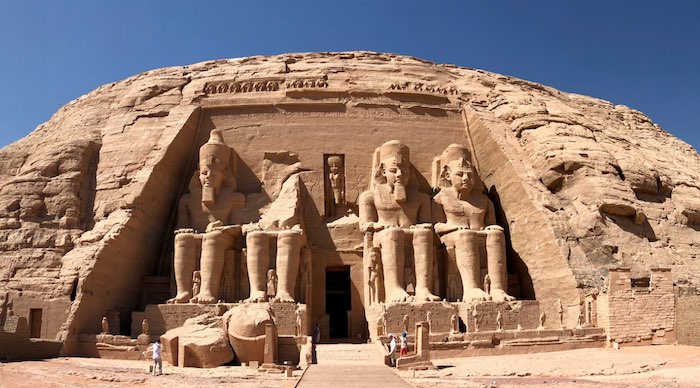
Abu Simbel is a marvel of ancient and modern engineering
I love looking out the window of an airplane at the earth far below, seeing where coast meets water or observing the eroded remains of some ancient formation in the changing light. Alas, the grimy desert sand hadn’t been cleaned from the windows of our EgyptAir jet, so we couldn’t see a thing as we flew over Lake Nasser en route to Abu Simbel. I was hopeful that this lack of attention to detail would not extend to other minor maintenance items, such as ensuring the cabin was pressurized or the fuel tank full.
We had just spent a week on a dahabiya sailboat cruising the Nile River, and after disembarking at Aswan, were headed further south to see one of Egypt’s great
monuments. There are a couple of ways to get to Abu Simbel from Aswan. You can ride a bus for 4 hours through the scorched Sahara Desert, or you can take a plane for the short 45-minute flight.
Opaque windows notwithstanding, I was glad we had chosen travel by air. Abu Simbel is spectacular, but there’s really not much to see except the monument itself and a small adjacent museum. So most tourists, us included, make the return trip in a day. And fortunately we had Sayed Mansour, an Egyptologist, on board. Sayed was there to explain all and clear our pained expressions.
Although it was early November, the intense Nubian sun was almost directly overhead, so Sayed led us to a quiet, shady spot where he began our introduction to
Egyptian history. Abu Simbel is a marvel of engineering — both modern and ancient. The temples were constructed during the reign of Ramses II. Carved from solid rock in a sandstone cliff overlooking the mighty river, these massive twin temples stood sentinel at a menacing bend in the Nile — and served as an intimidating obstacle to would-be invaders — for over 3000 years. But eventually Abu Simbel fell into disuse and succumbed to the inevitable, unrelenting Sahara. The site was nearly swallowed by sand when it was “rediscovered” by European adventurers in the early 19 th century. After years of excavation and restoration, the monuments resumed their original glory.
Then, in the 1960’s, Egyptian president Abdel Nasser decided to construct a new “High Dam” at Aswan. Doing so would create the largest man-made lake in the
world, 5250 sq km of backed-up Nile River. This ambitious project would bring economic benefit to parched Egypt, control the unpredictable annual Nile flood and also supply hydroelectric power to a poor, under-developed country. With the dam, the lights would go on in most Egyptian villages for the first time. But there were also a couple of drawbacks, which were conveniently swept under the water carpet by the government. The new reservoir would displace the local Nubian population whose forbearers had farmed the fertile banks of the Nile River for millennia. And many of Egypt’s greatest monuments and tombs would be forever submerged beneath the deep new basin — Abu Simbel included. But the government proceeded with the dam, monuments be damned.
Only after the water began to rise did an international team of archaeologists, scientists — and an army of labourers — begin the process of preserving these
colossal wonders. In an urgent race against the rising tide, the temples of Abu Simbel were surgically sliced into gigantic pieces, transported up the bank to safety and reassembled. The process was remarkable, a feat of engineering genius. And today the twin edifices, honouring Ramses and his wife Nefertari remain, gigantic, imperious and intact. But instead of overlooking a daunting corner of the Nile, this UNESCO World Heritage site now stands guard over a vast shimmering lake.
Sayed led us into the courtyard from our shady refuge and pointed to the four giant Colossi that decorate the exterior façade of the main temple. These statues of
Ramses were sculpted directly from Nile bedrock and sat stonily observing the river for 33 centuries. It was brutally hot under the direct sun. I was grateful for the new hat I had just acquired from a gullible street merchant. Poor fellow didn’t know what hit him. He started out demanding $40, but after a prolonged and brilliant negotiating session, I closed the deal for a trifling $36. It was difficult to hold back a grin as I sauntered away sporting my new fedora — although the thing did fall apart a couple of days later.
Sayed walked us toward the sacred heart of the shrine and lowered his voice. Like all Egyptians, Sayed’s native tongue is Arabic. But, oddly, his otherwise perfect English betrayed a slight cockney accent. (Sayed later disclosed that he had spent a couple of years working in an East London parts factory.) He showed us how the great hypostyle hall of the temple’s interior is supported by eight enormous pillars honouring Osiris, god of the underworld.

Exploring the inner temple

Nefertari
Sayed then left us to our devices. There were no other tourists. We had this incredible place to ourselves. In the dim light, we scampered amongst the sculptures
and sarcophagi, wandering, hiding and giggling as we explored the interior and its side chambers. At the far end lay the “the holiest of holies” a room whose walls were adorned with ornate carvings honouring the great Pharaoh’s victories — and offering tribute to the gods that made Ramses’ triumphs possible.
Exterior photographs of Abu Simbel are permitted, but pictures from within the sanctuary are verboten — a rule strictly enforced by the vigilant temple guardians — unless you offer a little baksheesh… in which case you can snap away to your heart’s content. Palms suitably greased, the caretakers are happy to pose with you in front of a hidden hieroglyph or a forbidden frieze, notwithstanding the stern glare of Ramses looking down from above.

A little baksheesh is key to holding the key
After our brief few hours at Abu Simbel, we hopped back on the plane. The panes weren’t any clearer but, acknowledging that there really wasn’t much to see in the Sahara — and that dirty airplane windows are not really a bona fide safety concern — I took time on the short flight to relax and bone up on Ramses the Great, whose mummified body awaited us at the Egyptian Museum in Cairo.
Exodus Travel skilfully handled every detail of our Egypt adventure: www.exodustravels.com/
Gerry Feehan is an award-winning travel writer and photographer. He lives in Kimberley, BC.

Thanks to Kennedy Wealth Management for sponsoring this series. Click on the ads and learn more about this long-term local business.
Gerry Feehan
Cairo – Al-Qahirah
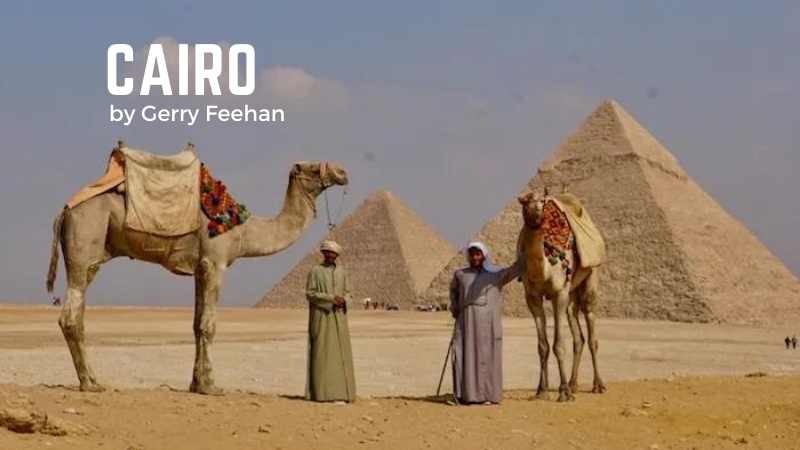
The Pyramids of Giza
The first thing one notices upon arrival in Egypt is the intense level of security. I was screened once, scanned twice and patted down thrice between the time we landed at the airport and when we finally stepped out into the muggy Cairo evening. At our hotel the scrutiny continued with one last investigation of our luggage in the lobby. Although Egyptian security is abundant in quantity, the quality is questionable. The airport x-ray fellow, examining the egg shaker in my ukulele case, sternly demanded, “This, this, open this.” When I innocently shook the little plastic thing to demonstrate its impermeability he recoiled in horror, but then observed it with fascination and called over his supervisor. Thus began an animated, impromptu percussion session. As for the ukulele, it was confiscated at hotel check-in and imprisoned in the coat check for the duration of our Cairo stay. The reasons proffered for the seizure of this innocuous little instrument ranged from “safety purposes” to “forbidden entertainment”. When, after a very long day, we finally collapsed exhausted into bed, I was shaken — but did not stir.
Al-Qahirah has 20 million inhabitants, all squeezed into a thin green strip along the Nile River. Fading infrastructure and an exponential growth in vehicles have contributed to its well-deserved reputation as one of the world’s most traffic-congested cities. The 20km trip from our hotel in the city center, to the Great Pyramid of Cheops at Giza across the river, took nearly two hours. The driver smiled, “Very good, not rush hour.”
Our entrance fee for the Giza site was prepaid but we elected to fork out the extra Egyptian pounds to gain access to the interior of the Great Pyramid. Despite the up-charge — and the narrow, dark, claustrophobic climb – the reward, standing in Cheop’s eternal resting place, a crypt hidden deep inside the pyramid, was well worth it. We also chose to stay after sunset, dine al fresco in the warm Egyptian evening, and watch the celebrated ‘sound and light’ performance. The show was good. The food was marginal. Our waiter’s name was Fahid. Like many devout Muslim men, he sported a zabiba, or prayer bump, a callus developed on the forehead from years of prostration. Unfortunately throughout the event Fahid hovered over us, attentive to the point of irritation, blocking our view of the spectacle while constantly snapping fingers at his nervous underlings. The ‘son et lumière’ show was a little corny, but it’s pretty cool to see a trio of 4500-year-old pyramids – and the adjoining Great Sphinx — illuminated by 21 st century technology.

The Great Sphinx

Giza at nightThe next night our group of six Canucks attended an Egyptian cooking class. Our ebullient hostess was Anhar, (‘the River’ in Arabic). Encouraged by her contagious enthusiasm, we whipped up a nice tabouli salad, spicy chicken orzo soup and eggplant moussaka. We finished up with homemade baklava. Throughout the evening, Anhar quizzed us about the ingredients, the herbs and spices, their origins and proper method of preparation. Anyone who answered correctly was rewarded with her approving nod and a polite clap. Soon a contest ensued. Incorrect answers resulted in a loud communal ‘bzzzt’ — like the sound ending a hockey game. It’s not polite to blow one’s own horn, but the Feehan contingent acquitted themselves quite nicely. If I still had her email, Anhar could confirm this.
Cairo was not the highlight of our three-week Egyptian holiday, but a visit to the capital is mandatory. First there’s the incredible Pyramids. But as well there’s the Egyptian Museum that houses the world’s largest collection of Pharaonic antiquities including the golden finery of King Tutankhamen and the mummified remains of Ramses the Great. Ramses’ hair is rust coloured and thinning a little, but overall he looks pretty good for a guy entering his 34 th century.

Ramses the Great

Then there’s Khan el-Khalili, the old souk or Islamic bazaar. We strolled its ancient streets and narrow meandering alleyways, continually set upon by indefatigable street hawkers. “La shukraan, no thanks,” we repeated ineffectually a thousand times. The souk’s cafes were jammed. A soccer match was on. The ‘beautiful game’ is huge in Egypt. Men and women sat, eyes glued to the screen, sipping tea and inhaling hubbly bubbly.

The Old Souk Bazaar

Selfies, Souk style
An aside. When traveling in Egypt, be sure to carry some loose change for the hammam (el baño for those of you who’ve been to Mexico). At every hotel, restaurant, museum and temple — even at the humblest rural commode — an attendant vigilantly guards the lavatory. And have small bills for the requisite baksheesh. You’re not getting change.
After our evening in the souk we had an early call. Our guide Sayed Mansour met us at 6am in the hotel lobby. “Yella, yella. Hurry, let’s go,” he said. “Ana mish bahasir – I’m not joking.” “Afwan,” we said. “No problem,” and jumped into the van. As we pulled away from the curb Sayed began the day’s tutorial, reciting a poem by Percy Blythe Shelly:
I met a traveller from an antique land,
Who said—“Two vast and trunkless legs of stone
Stand in the desert. . . . My name is Ozymandias, King of Kings;
Look on my Works, ye Mighty, and despair!”
And we were off, through the desert, to Alexandria. Founded by Alexander the Great in 332 BC, Egypt’s ancient capital was built on the Nile delta, where the world’s longest river meets the Mediterranean Sea. The day was a bit of a bust. The city was once renowned for its magnificent library and the famed Lighthouse of Alexandria. But the former burnt down shortly after Christ was born and the latter — one of the original seven wonders of the ancient world – toppled into the sea a thousand years ago. Absent some interesting architecture, a nice view of the sea from the Citadel — and Sayed’s entertaining commentary — Alexandria wasn’t really worth the long day trip. Besides, we needed to get back to Cairo and pack our swimwear. Sharm el Sheikh and the warm waters of the Red Sea were next up on the Egyptian agenda.

Gerry with some Egyptian admirers
Exodus Travel skilfully handled every detail of our trip: www.exodustravels.com And, if you’re thinking of visiting Egypt, I can suggest a nice itinerary. No sense reinventing the pyramid: [email protected]
Gerry Feehan is an award-winning travel writer and photographer. He lives in Kimberley, BC.

Thanks to Kennedy Wealth Management for sponsoring this series. Click on the ads and learn more about this long-term local business.
-

 Daily Caller2 days ago
Daily Caller2 days agoTrump Executive Orders ensure ‘Beautiful Clean’ Affordable Coal will continue to bolster US energy grid
-

 2025 Federal Election2 days ago
2025 Federal Election2 days agoBREAKING from THE BUREAU: Pro-Beijing Group That Pushed Erin O’Toole’s Exit Warns Chinese Canadians to “Vote Carefully”
-

 Business2 days ago
Business2 days agoChina, Mexico, Canada Flagged in $1.4 Billion Fentanyl Trade by U.S. Financial Watchdog
-

 COVID-191 day ago
COVID-191 day agoTamara Lich and Chris Barber trial update: The Longest Mischief Trial of All Time continues..
-
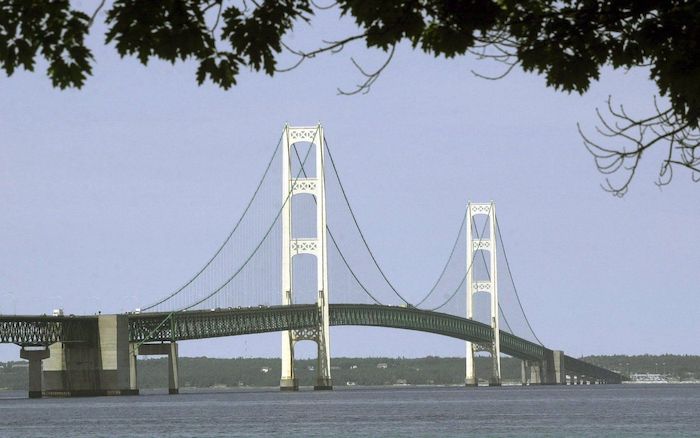
 Energy1 day ago
Energy1 day agoStraits of Mackinac Tunnel for Line 5 Pipeline to get “accelerated review”: US Army Corps of Engineers
-

 2025 Federal Election2 days ago
2025 Federal Election2 days agoAllegations of ethical misconduct by the Prime Minister and Government of Canada during the current federal election campaign
-
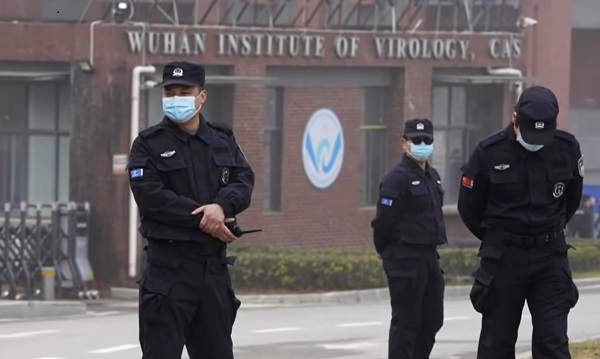
 Daily Caller24 hours ago
Daily Caller24 hours agoDaily Caller EXCLUSIVE: Trump’s Broad Ban On Risky Gain-Of-Function Research Nears Completion
-

 Daily Caller2 days ago
Daily Caller2 days agoDOJ Releases Dossier Of Deported Maryland Man’s Alleged MS-13 Gang Ties







